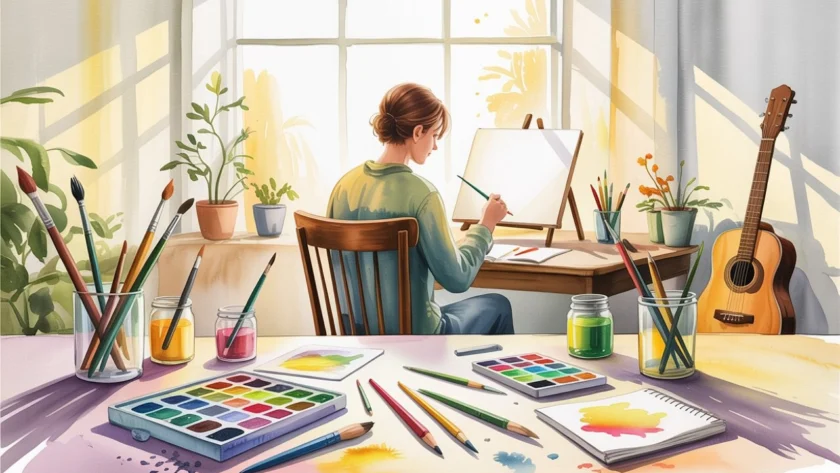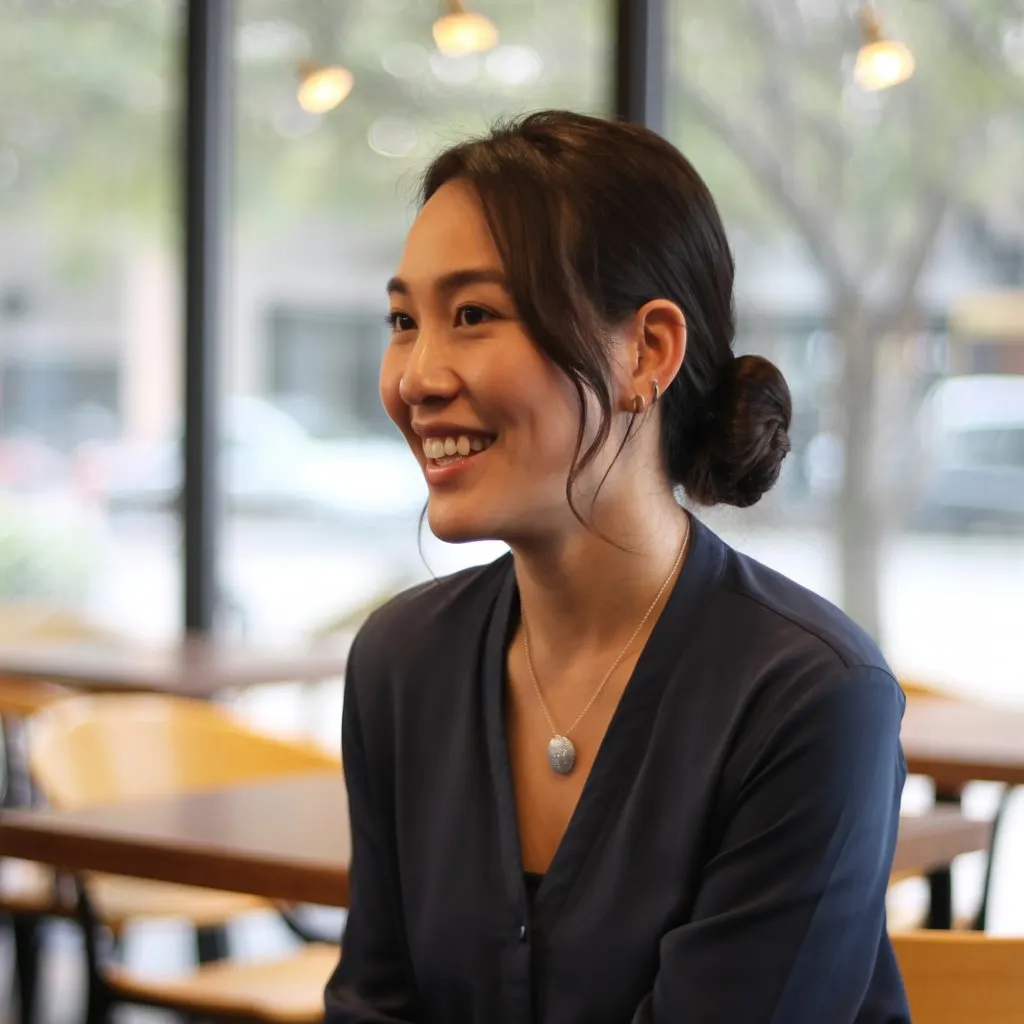I’ll never forget the afternoon I sat frozen on my couch, chest tight, thoughts racing so fast I couldn’t catch a single one. My therapist had suggested I try journaling, and honestly? I’d rolled my eyes. How could scribbling in a notebook possibly touch the kind of anxiety that made my hands shake and my heart pound? But desperation has a way of making us try things we’d normally dismiss. So I grabbed a cheap notebook and started writing—not pretty, organized thoughts, but raw, messy words that spilled out like water from a broken dam.
That simple act of putting pen to paper became my first real experience with creative expression as anxiety relief. And friends, I’ve discovered something powerful in the years since: God designed us as creative beings, made in the image of the ultimate Creator. When we engage in creative outlets like art, music, or writing, we’re not just distracting ourselves from anxiety—we’re tapping into something deeply human and profoundly healing.
If you’re struggling with anxiety right now, wondering if creative activities could really make a difference, let me share what I’ve learned through both personal experience and working with countless others on this journey.
Why Creative Expression Works for Anxiety
Here’s what I wish someone had told me years ago: creativity isn’t just for “artistic people.” It’s a fundamental way our brains process emotion, stress, and experience. When anxiety hijacks our nervous system and sends us into fight-or-flight mode, creative activities offer a pathway back to regulation that talk therapy or logic alone sometimes can’t reach.
Think about it this way—anxiety lives in our heads, looping the same worried thoughts endlessly. But when we paint, play music, or write, we’re engaging different parts of our brain. We’re moving that anxious energy from the spinning wheel of our thoughts into something tangible and real. It’s like giving anxiety a different job to do, one that doesn’t involve imagining worst-case scenarios at 3 AM.
I’ve also come to understand that creative expression connects beautifully with our faith. Throughout Scripture, God invites us to “cast our cares” upon Him (1 Peter 5:7). Sometimes that casting looks like prayer. But sometimes it looks like pouring our worries into a painting or playing out our frustration on piano keys. The Psalms themselves are creative expressions of every human emotion—including anxiety, fear, and doubt. David didn’t just think about his troubles; he wrote poetry and music about them.
The Healing Power of Visual Arts
When I first tried painting during a particularly rough anxiety season, I had zero expectations. I picked up some cheap watercolors from the craft store, spread newspaper on my kitchen table, and just… started. No plan, no goal, just moving color around on paper. Something shifted in my chest that afternoon. The constant mental chatter quieted just a bit.
Visual arts—whether painting, drawing, coloring, sculpting, or collage—engage our hands and eyes in ways that naturally calm our nervous system. There’s actually science behind this (research shows that just 45 minutes of creative activity significantly reduces cortisol levels), but what matters more is how it feels: grounding, present, focused.
You don’t need to be “good at art” for this to work. In fact, releasing the pressure to create something beautiful is part of what makes art therapy so effective for anxiety. When I’m feeling overwhelmed, I sometimes just paint swirls of color or draw repetitive patterns. The process matters more than the product.
Getting Started with Visual Arts for Anxiety Relief
Let me share some practical ways to incorporate visual creativity into your anxiety management:
Start ridiculously simple. Grab adult coloring books if you’re feeling intimidated. There’s no shame in this—coloring engages your focus and creativity without the pressure of a blank page. I keep one next to my bed for nights when anxious thoughts won’t quiet down.
Create anxiety art. This might sound counterintuitive, but sometimes expressing anxiety through art helps release its grip. When you’re feeling anxious, try drawing what it feels like—dark colors, jagged lines, chaotic patterns. Then, create a second piece representing peace or God’s presence. The contrast can be remarkably healing.
Make it a spiritual practice. I’ve started what I call “prayer painting.” I put on worship music, invite God into the creative process, and let the act of creating become a form of meditation and prayer. Sometimes I paint Scripture verses. Sometimes I just let colors represent my prayers when words won’t come.
Release perfectionism at the door. This one’s huge for anxious minds like ours that tend toward perfectionism. Your art doesn’t need to be Instagram-worthy. It just needs to be honest. Some of my most therapeutic art sessions have produced the “ugliest” pieces—and that’s exactly the point.
Music as Medicine for the Anxious Soul
Music holds a special place in the anxiety healing toolkit, and I’m convinced it’s no accident. Throughout Scripture, music appears again and again as a source of comfort, worship, and even spiritual warfare. When Saul was tormented by anxiety and dark moods, David played the harp, and the music brought relief (1 Samuel 16:23). There’s something profoundly spiritual about music’s power to shift our emotional and mental state.
Whether you play an instrument, sing, or simply listen with intention, music impacts anxiety on multiple levels. It regulates breathing patterns, alters brainwave activity, and releases dopamine—our brain’s feel-good chemical. But beyond the biology, music speaks to our souls in ways that bypass our overthinking minds.
I can’t count the number of panic attacks I’ve talked myself down from by putting on worship music and focusing on the lyrics and melody instead of my racing thoughts. Music gives anxiety less space to dominate because it fills our mental space with something else—something beautiful and often something that points us back to God’s truth.
Practical Ways to Use Music for Anxiety Relief
Create anxiety playlists. I keep several playlists on my phone for different anxiety states. One for panic attacks with slow, calming instrumental music. One with worship songs that remind me of God’s faithfulness. One with upbeat music for when anxiety makes me want to hide but I need to push through. Having these ready means I don’t have to think when anxiety hits—I just press play.
Learn an instrument (any instrument). You don’t need to become a virtuoso. Learning even simple songs on guitar, piano, or ukulele gives your brain something to focus on and creates a sense of accomplishment that anxiety tries to steal. I picked up the ukulele in my mid-thirties specifically as an anxiety outlet, and those 15-minute practice sessions have become sacred grounding time for me.
Sing it out. This one might feel awkward at first, but singing—even if you think you can’t carry a tune—is phenomenally good for anxiety. It deepens breathing, releases tension, and when you’re singing worship songs or hymns, it becomes a form of prayer. I sing in my car, in the shower, while cooking. Sometimes I’m worshiping; sometimes I’m just getting anxious energy out of my body. Both matter.
Use music mindfully. Instead of always having music as background noise, try really listening. Put on a song, close your eyes, and notice every instrument, every vocal nuance. This kind of focused listening is a form of meditation that naturally quiets anxious thoughts.
Writing: Giving Voice to What’s Inside
Of all the creative outlets I’ve explored for anxiety relief, writing has been the most transformative for me personally. There’s something about translating the chaos in our minds into words on a page that makes anxiety feel less overwhelming and more manageable. When I write about my anxiety, I’m no longer drowning in it—I’m observing it, understanding it, and often finding God’s perspective in the middle of it.
Writing for anxiety relief can take many forms, and none of them require you to be a “writer.” You’re not creating content for anyone else. You’re creating space for yourself to process, release, and sometimes discover things you didn’t know you were thinking or feeling.
The Psalms have been my model for this. David wrote with raw honesty about his fears, his anger, his confusion—and then often (though not always immediately) found his way back to trust in God. That’s what anxiety writing can do. It gives us a place to be completely honest, including about our doubts and fears, and then invites God into that honest space.
Types of Writing for Anxiety Relief
Stream-of-consciousness journaling. This is where you write whatever comes to mind without editing, organizing, or censoring. When anxiety is high, I set a timer for ten minutes and just write. Sometimes it’s coherent; often it’s not. That’s fine. I’m not writing for clarity—I’m writing to release the pressure valve in my mind.
Gratitude journaling with a twist. Traditional gratitude lists are great, but when you’re anxious, they can feel trite or forced. Instead, I write about “evidence of God’s faithfulness today.” It might be something big or something tiny—hot coffee, a text from a friend, making it through a meeting without a panic attack. This practice trains my anxious brain to notice God’s presence even in hard seasons.
Letter writing. Sometimes I write letters to God, pouring out everything I’m worried about as if I’m talking to my closest friend—because I am. Other times I write letters to my anxiety itself, telling it why it’s wrong or how it’s affecting me. I’ve even written letters to my future self, reminding her that she’s survived 100% of her worst days so far.
Creative writing and poetry. You don’t have to be a poet to benefit from playing with words and metaphors. I’ve written terrible poetry about anxiety that no one will ever read, but the process of finding images and words to describe my experience helped me understand it better. Sometimes I rewrite familiar Bible verses in my own words or write imaginative prayers.
Anxiety tracking. This is more structured but incredibly helpful. I keep a simple log noting when anxiety spikes, what triggered it, what helped, and where I sensed God’s presence in it. Over time, patterns emerge that help me anticipate and manage anxiety more effectively.
Creating Your Personal Creative Practice
Now, I know what you might be thinking: “This sounds great, but I barely have time to shower some days. How am I supposed to add creative practices to my life?” I get it. Anxiety already steals so much of our energy and time. But here’s what I’ve discovered—creative outlets don’t have to be elaborate or time-consuming to be effective.
Start with just five or ten minutes. Keep supplies easily accessible—a sketchbook on your coffee table, a journal by your bed, a ukulele in the living room. The lower the barrier to entry, the more likely you are to actually do it when anxiety hits.
I’ve also learned to think of creative expression as part of my spiritual disciplines, not separate from them. Just as I make time for prayer and Bible reading (even when it’s brief), I make time for creativity. Some mornings, my “devotion time” is painting while listening to worship music. Some evenings, my prayer time is journaling my anxious thoughts and then writing out Scripture promises. God meets us in these creative spaces just as much as in traditional prayer.
Consider creating a “creativity corner” in your home—a small space dedicated to your creative anxiety relief practices. Mine is just a corner of my bedroom with a small desk, my watercolors, my journal, and my ukulele. When I sit in that space, my brain knows: this is where we process, create, and find peace.
The Spiritual Dimension of Creative Healing
What makes creative outlets particularly powerful for Christian anxiety sufferers is that they create space for God to speak and work in ways that our anxious, overthinking minds often block. When I’m painting or playing music or writing, I’m not trying to figure everything out or control outcomes—I’m simply being present, creating, and allowing God to meet me there.
I’ve had some of my most profound spiritual moments not during formal prayer times, but while engaged in creative expression. There’s something about quieting the analytical, worried mind that allows our spirits to be more receptive to God’s still, small voice. Jesus often used creative elements—stories, word pictures, metaphors—to teach truth. Maybe engaging our own creativity opens us to receive His truth in deeper ways.
Remember Philippians 4:8: “Whatever is true, whatever is noble, whatever is right, whatever is pure, whatever is lovely, whatever is admirable—if anything is excellent or praiseworthy—think about such things.” Creative expression helps us dwell on these things instead of dwelling on worst-case scenarios. When we create beauty, we reflect our Creator. When we express ourselves honestly, we practice the vulnerability and authenticity God desires from us.
Moving Forward with Creative Courage
If you’re reading this and feeling skeptical—maybe because you’ve never thought of yourself as creative or because anxiety has convinced you that nothing will really help—I want to gently encourage you to try anyway. You don’t need to be an artist, musician, or writer. You just need to be willing to try something different, to give your anxiety a different outlet than the same mental spirals you’ve been stuck in.
Start small. Pick just one creative outlet that seems least intimidating. Give yourself permission to be terrible at it. Remember that the goal isn’t to create masterpieces—it’s to create space for healing, expression, and God’s presence.
Keep your expectations realistic. Creative expression won’t cure anxiety or replace necessary professional help or medication. But it can be a powerful tool in your anxiety management toolkit, one that engages your whole self—mind, body, and spirit—in the healing process.
And know this: the God who created you with unique gifts, personality, and experiences also created you with creativity woven into your very being. When you engage in creative expression, you’re not just managing anxiety—you’re reclaiming part of who God made you to be. Anxiety wants to silence you, shrink you, and steal your joy. Creativity is one way you fight back.
So grab that sketchbook. Pick up that guitar. Open that journal. Not because you have to, but because you get to. Because you are more than your anxiety, and your voice—expressed through whatever creative outlet speaks to you—deserves to be heard.
The canvas is waiting. The page is blank. The instrument is ready. And God is right there with you, ready to meet you in the creative process and bring healing to your anxious heart.




